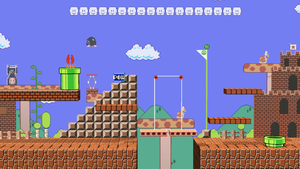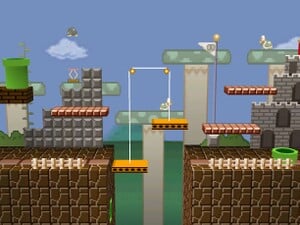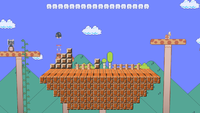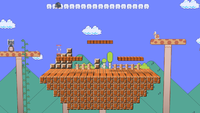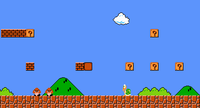Mushroom Kingdom (SSB)
| Super Mario Bros. Mushroom Kingdom | |
|---|---|
Mushroom Kingdom as it has appeared in the Smash series. | |
| Universe | Mario |
| Appears in | SSB Ultimate |
| Availability | Unlockable (SSB) Starter (Ultimate) |
| Unlock criteria | Clear 1-Player mode with the eight starter characters, and play every other stage in Vs. Mode. |
| Crate type | Normal |
| Article on Super Mario Wiki | Mushroom Kingdom |
Mushroom Kingdom (いにしえの王国, Ancient Kingdom) is the only unlockable VS. Mode stage in Super Smash Bros. While it does not return in Super Smash Bros. Melee, a similar stage also called Mushroom Kingdom appears. The stage later returns in Super Smash Bros. Ultimate as a familiar stage, visually appearing more in-line to the original Super Mario Bros. and the aforementioned Melee stage, while its original version had a darker color scheme.
This stage is the only one which is never seen in 1-Player mode: even if it is unlocked, Mario and Luigi will still be fought on Peach's Castle.
Stage overview[edit]
In the middle of this stage is a pit. To the right of it, there are two soft floating platforms, and a pipe to the right of them. To the left of the hole, there is a single floating soft platform, and a solid brick platform left of that which extends to the edge of the stage. In the background, a grey castle can be seen, along with some mushroom platforms.
This stage is unique among the ones in Smash 64 in that it features walk-off blast lines: this is even further referenced by a "danger" sign that appears beyond the blast lines themselves.
There are three pipes which characters can warp in between. When standing on a pipe, if the player presses down on the controller, their character will transfer through to another pipe. In Ultimate, down must be held for a moment before the pipe will be entered, and after a character travels through one, they cannot use the pipes again for another 13 seconds to prevent abuse of the warps. One of these pipes is on the ground to the right of the stage, and another is on top of the brick platform to the left. There is a third pipe embedded in the left wall of the chasm, in such a way that only its mouth can be seen; in 64 this pipe is exit-only but enterable in Ultimate by holding left while next to it, although there is a chance the pipe will reject the character and immediately spit them back out. Characters are randomly sent to either pipe, although if one pipe is blocked, the character will always come out of the alternate pipe. Additionally, two Piranha Plants occasionally come out of the pipes and inflict damage (5% in 64, 12% in Ultimate), but can be knocked away with a powerful attack (or by hitting them enough times). The Piranha Plants knock any characters who hit them straight upward with relatively high base knockback albeit low knockback scaling, usually not KOing until very high percentages, except for the top pipe. They can be used during combos or to setup moves. Using the pipes is not typically a reliable strategy, as the player may exit into the abyss, which could lead to the player falling down the bottom blast line and self-destructing, or at minimum being left open to attack.
In the middle of this stage is a fissure, which is the only place in the stage where players can be KO'd by falling down. Above the crevasse is a scale with two soft platforms. It is possible to stand on the two platforms, but the character's weight will unbalance them. If unbalanced too far, the system will break and fall into the crevasse, and then regenerate a few seconds afterwards. This gap is the cause of many AI flaws.
Occasionally, a small, rectangular POW Block will appear in one of several locations in the air. Hitting it with an attack will cause the screen to vibrate, with every character touching the ground or a platform being dealt 20% damage and great knockback, though in Ultimate, it has low knockback scaling, and so won't KO until very high percents unless the opponent is on a high platform.
Star KOs and Screen KOs are disabled here in Super Smash Bros. Ultimate, and is the only stage returning from Smash 64 with this distinction.
Technical information[edit]
In Smash 64, landing on one of the scale platforms will impart a speed of -8×(2.4-w)+0.9, where w is the fighter's weight. Every frame afterwards will accelerate the platform by -(2.4-w)+0.9. When both platforms have a fighter on them, the left platform (the right platform bases its movements on the left) will change its speed every frame using (s+(w1-w2))×0.93, where s is the platform's current speed and w1 and w2 are the weights on each platform, up to a speed of around (w1-w2)×1.32857. Due to how speed is calculated, a weight above around 1.5174 will not cause the platforms to break off in a single jump (jumping after it has moved will impart the same speed as the first but at a lower height, thus allowing it to break), a weight of 2.4 will do nothing, and a weight above 2.4 will cause the platform to rise; these scenarios are not possible without hacking as the highest weight value is 1.3 with Jigglypuff.
The left platform starts at a height of 363 and the right platform starts at 362. Once the difference between one of the platform's starting height and current height exceeds 1100, the platform will become detached from the rope. Once detached, the platforms' speed is reset to 0 and increases by 3 every frame until it reaches 70. The platforms will continue to fall until both pass a height of -5350, at which point they will reappear 3 seconds later.
In Ultimate, the platform's movements are simpler; while jumping onto a platform will impart an initial speed like in Smash 64, this speed quickly dissipates and is overtaken by the primary mechanic. When landing on one platform, that platform will fall at a constant rate of around 0.008675w-0.35 units per frame, where w is the fighter's weight with a minimum of 40. When both platforms have a fighter on them, the one with the heaviest fighter will fall at a rate of 0.0135×(w1-w2) units per frame (the other platform will rise at the same rate), where w1 and w2 are the weights on each platform. Both platforms start at a height of 13 units and detach from the rope when the difference in starting height and the current height is more than 40. The platform has a max speed of around 1.08 units per frame, reaching it at a weight of around 165 or a weight difference of around 80.
Ω form and Battlefield form[edit]
In Super Smash Bros. Ultimate, the Ω form and Battlefield form are suspended in the air with no platforms extending below the blast line and no walk-offs. The walk-offs, POW Block, scales, and Warp Pipes are also absent. The main platform is an arrangement of ground blocks that match the size and shape of Final Destination and Battlefield, respectively. In order for fighters to not get stuck in the corners when recovering, and to make this form match their respective forms, there are invisible slopes along both sides. The three soft platforms of the Battlefield form are based off the soft platforms of the regular form.
Hazards Off[edit]
With stage hazards turned off in Ultimate, POW blocks and Piranha Plants never appear, it’s impossible to use the warp pipes, and the balancing platforms are absent.
Origin[edit]
This stage is based on the overworld levels of Super Mario Bros. The overworld levels often feature ground blocks as the main platform, and a background consisting of green mountains and blue cloudy skies. In each overworld level, the player must reach the Fortress at the end of each level by touching the Goal Pole.
The overworld levels often featured a ground block as the main platform. Among the other platforms include the Brick Blocks, which can be destroyed by hitting them from underneath; the mushroom-shaped platforms introduced in World 4-2; and the Cloud Block featured in hidden areas above the ground, which can be accessed by a hidden beanstalk serving as a ladder. The ? Blocks will often turn into Empty Blocks after being hit, either to release items or to release a beanstalk that leads the player to the hidden areas above the ground. The overworld levels also feature Warp Pipes, where some of them allow the player to access underground levels or bonus rooms. When underground, the player has to go into another Warp Pipe to return to the overworld. A few overworld levels also features the jumping boards, which allows the player to jump with extra height when pressing the jump button at the right time.
The Scale Lifts also debuted as platforms in World 3-3 in Super Mario Bros. When the player stands on one platform, it will drop down while the other platform connected to it goes up. If the player stands on the platform for too long, the scale breaks and both platforms fall.
The Piranha Plant is a common enemy in the Mario series that often emerge from Warp Pipes as a hazard. In Super Mario Bros., the Piranha Plants are depicted green, but in Super Mario Bros.: The Lost Levels, they are depicted as red, starting from World 4 onward. Other enemies in Super Mario Bros. featured include the Koopa Troopa, the Bullet Blaster, capable of shooting Bullet Bills, and the Buzzy Beetle, which is seen bouncing on a trampoline. In Super Smash Bros., the 8-bit Koopa Troopa is depicted with a green shell, while in Ultimate, it is depicted with a red shell. Green Koopa Troopas always walk off of cliffs in Mario games, while Red Koopa Troopas will walk away from cliffs, as the Koopa Troopas in the stage background do, so the change makes the stage more faithful to Super Mario Bros.
The POW Block is an item that debuted in the Mario Bros. arcade game and has appeared in numerous Mario titles since. When the POW Block is hit, it causes an earthquake and the enemies to be affected. In Mario Bros., the POW Block causes the enemies to flip over on their backs, leaving them vulnerable to getting kicked out. In later Mario titles, the POW Block causes all enemies onscreen to be eliminated. The POW Block does not appear in Super Mario Bros. nor its visually near-identical Japanese sequel The Lost Levels, however it did appear in Super Mario Bros. 2 as well as its original non-Mario incarnation Yume Kōjō: Doki Doki Panic. Super Mario Bros. 3 featured a bonus game based on Mario Bros., but the POW Block was removed from it. The POW Block would eventually appear alongside SMB1 graphics outside of Smash for the first time in the Nintendo DSi utility app Mario Clock, released 10 years after Super Smash Bros.
This stage features multiple elements from the overworld levels in Super Mario Bros., albeit with some visual differences between their appearances in Super Smash Bros. and Ultimate. Ultimate uses direct sprite rips from Super Mario Maker, which itself used near-identical proximities of the Super Mario Bros. sprites, while the original Super Smash Bros. uses sprites that appear to have been traced or redrawn as opposed to ripped from the NES game, with incorrect colors, inconsistent pixel widths, and more shading detail than possible on the NES.
Tournament legality[edit]
This stage is universally banned in standard tournaments due to hazards such as the POW blocks and randomized Piranha Plants disrupting gameplay, the pipes allowing heavy side camping, and the walk-off blast lines allowing even further side camping and allowing characters who can chaingrab past the blast line (such as Pikachu using its forward throw) to KO at very low percentages. Alongside Sector Z, it has never been considered a legal stage.
Gallery[edit]
Super Smash Bros.[edit]
Super Smash Bros. Ultimate[edit]
Piranha Plant firing poison at Toon Link on the stage.
Names in other languages[edit]
Trivia[edit]
- Every subsequent installment in the Super Smash Bros. series has had a Mushroom Kingdom-based stage (a stage related to "Mushroom Kingdom", or any name based on that phrase). Melee had Mushroom Kingdom and the Super Mario Bros. 2-based Mushroom Kingdom II, Brawl had Mushroomy Kingdom, Super Smash Bros. 4 had Mushroom Kingdom U in the Wii U version and Mushroomy Kingdom as a returning stage in the 3DS version, and Ultimate had all of the Mushroom Kingdom stages, except for Melee's Mushroom Kingdom.
- In Ultimate, this stage is referred within game files with the codename "mario_past64". The phrase "past" can be an alternative to "ancient", the stage's Japanese name, and is shared with Mushroom Kingdom II and Mushroomy Kingdom.
- In Ultimate, if the game speed is modified via Special Smash or Training Mode, the amount of time a player must hold the stick in contact with the pipe to enter it is higher. Notably, this makes it noticeably harder for certain fighters to enter the side pipe.
- The German name of this stage in Super Smash Bros. translates to "Donut Plains", an unrelated location from Super Mario World. In Ultimate, this has been corrected to reference Mushroom Kingdom.
- During the final 30 seconds of the match and Sudden Death, the "Hurry up!" jingle will play and the music will speed up (as it does in Super Mario Bros. when the timer reaches 100 units). In Ultimate only, this also occurs when one of the fighters is on their last stock.
- This is one of the five stages in the Smash Bros. series to change music when the timer reaches 30 seconds and during Sudden Death, the others are Mushroom Kingdom (SSBM), Mushroom Kingdom II, Suzaku Castle (if the music played is any type of one of the sixteen playable characters in Street Fighter II and Super Street Fighter II), and Moray Towers.
- In Ultimate, if the Ice Climbers use the pipes, one may not come out of the same pipe as the other. In addition, Pikmin and Luma cannot use the pipes.
- Also in Ultimate, this is one of the few stages where every Assist Trophy and every Poké Ball summon can appear.
- In Smash 64, all characters have unique animations for entering and exiting the pipes. However, this isn't present in Ultimate.
- This stage and Saffron City share the longest gap between appearances in the Super Smash Bros. series, with nearly nineteen years between Smash 64 and Ultimate.
| Stages in Super Smash Bros. | |
|---|---|
| Starter stages | Congo Jungle · Dream Land · Hyrule Castle · Peach's Castle · Planet Zebes · Saffron City · Sector Z · Yoshi's Island |
| Unlockable stage | Mushroom Kingdom |
